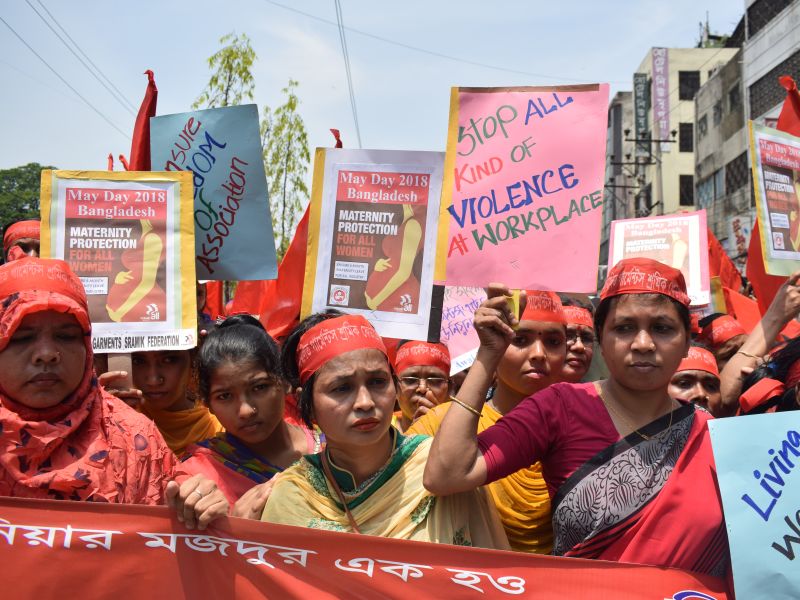Researching the politics of development
Blog

How women matter in making change
To mark International Women’s Day, Professor Sohela Nazneen presents the key findings of ESID’s work on women’s empowerment.
You need to have a seat at the table, the knowledge of how things work, and the allies and access to places where power resides to make change happen. It is often argued that there are fewer women in these powerful positions. Women are not part of the ‘old boys’ network’ that decides policy, and lack the insider knowledge of how things work to get change done. But, in the last 30 years, we have increasingly seen women pushing for and achieving change. Using case studies from ESID research conducted in Nepal, Bangladesh and Uganda, in this blog, I show how coalitions pushing for women’s empowerment policies go about securing policy change.
Understanding women’s capacity for making change
At the root of our research, we wanted to understand: what enables women to influence the implementation of policies that determine their legal status and wellbeing? Our focus was the micropolitics of policy making – getting into the finer details of individual policies related to women’s empowerment – and the role of individual actors and coalitions in pushing for these changes.
We framed this in an understanding of political settlements. Political settlements describe the nature and distribution of power between different actors and groups in a state. They influence what women’s rights and pro gender equality activists can achieve and how they go about influencing policy outcomes.
One of our key findings, apparent across all the countries we studied, was the importance of informal political practices in securing change. This includes women’s empowerment coalitions making deals behind the scenes, using their connections and networks to exert influence, and deploying campaigns that framed protecting women’s rights and interests as crucial to wider social progress.

Comparing Bangladesh, Uganda and Nepal
Our focus on Uganda, Bangladesh and Nepal allowed us to analyse gender equality reforms in three different political settlements, giving a view on how and why policies progressed as they did and whether they succeeded in each country. Before getting into the details of the policies, it’s useful to understand the political settlements in each country.
Bangladesh has two main political parties that tend to rotate in power with regular elections. In government, executive dominance is very strong, while the legislator is comparably weak. Religion maintains a strong conservative influence over certain policy areas, both through the Islamic party, Jamaat-E-Islami, and through civic platforms encompassing broader social groups.
Uganda’s National Resistance Movement has been the dominant party since it took power in the 1986 revolution, though its dominance has waned over time as opposition groups have gained in popularity. The president has a lot of power personally and the Church is still influential: religious networks can practically veto reforms if they go against strongly held beliefs and values.
Nepal, by contrast, is a multiparty democracy. Following the post-conflict transition in the middle of the last decade, political competition has strengthened, but with influence of Maoist thought maintained. Religious actors have less power, but caste-based informal coalitions exert influence.
How does women’s empowerment reform happen?
We sought to understand three questions in particular:
- How important are informal networks and practices?
- How do powerful women use informal institutions to create change?
- How does resistance to policy differ across policy issues?
In studying reforms around women’s empowerment and how resistance to pro gender equality change was organised, it’s useful to consider what kinds of policies were selected for the study. The kind of resistance women’s rights groups and pro gender equality coalitions face depends on the type of policy change being asked for, and the significance of using informal institutions varies across these policy cases. We identified three distinct types:
- Ameliorative policy change, which changes a woman’s condition, but doesn’t necessarily challenge male power, for example: policies guaranteeing education for girls.
- Transformative non-doctrinal policy change, which changes women’s status by challenging male power but is not necessarily linked to challenging religious values, for example: in advocating for domestic violence legislation.
- Transformative doctrinal policy change, which changes women’s status by challenging male power and religious codes or customary norms, for example: reforms to inheritance or land rights that benefit women.
Different types of policy change require different coalitions
We found that for transformative policy reform to succeed, pro gender equality coalitions needed to bring together a broad range of actors to form a coalition featuring ‘unusual suspects’.
In Uganda, for example, the coalition advocating for reforming domestic violence law brought the Catholic Church – traditionally a conservative influence – on board. The Church was a policy veto player, so the coalition needed its support to succeed. It did so by framing reducing domestic violence as an issue about protecting families, rather than women’s rights, thereby aligning with the Church’s priorities.
How do influential women wield power?
Individual women in powerful positions in the executive or the government can exert critical influence in the gender empowerment policy reform process. We found that women deployed their positional power as cabinet ministers, heads of ministries, prime ministers, and deputy speakers of the house to push women’s rights agendas when opposition stood in the way.
For example, in domestic violence law reform in Bangladesh, Shirin Sharmeen Chowdhury – the women’s minister – and her link with the prime minister was critical. Shirin Sharmeen personally intervened when the law ministry attempted to revise the draft legislation. At the same time, she kept the reform coalition in the loop about the discussion on the proposed act in the Cabinet so the policy coalition could focus on amending specific provisions.
Informal practices in policy resistance
Just as those promoting women’s rights employ informal practices, they are a crucial part of resistance to it. Resistance to changing the status quo varies across different women’s empowerment policies, depending on who may be seen as ‘losing out’ if women gain rights. It may, for example, be based on class dimensions, as was the case in Uganda’s land reform case, rather than as resistance to women’s rights per se.
In practice, resistance can take various forms. These could involve disrupting legislative protocol, as was the case in Ugandan land ownership reform, for example, when the opposition argued that the co-ownership clause was not adopted – as the reform had ‘not been spoken into the mike’, which is required by due process. In a similar vein, crucial files may simply ‘disappear’: the first draft of domestic violence legislation in Nepal was ‘lost’.
Tricks of the trade
In conclusion, while many are broadly aware that backroom deals and interpersonal relations between those in power can be crucial in making change happen, our research has provided examples of how this happens in practice in three countries, and efforts by women to advance improved rights, empowerment and legal protection. Just as the progressive coalitions used informal practices to create change, so did their opposition in blocking it. For women’s rights and gender equality advocates, it’s important to know when and how to deploy these informal tools, and to be aware that your opponents will likely be planning to do the same.
